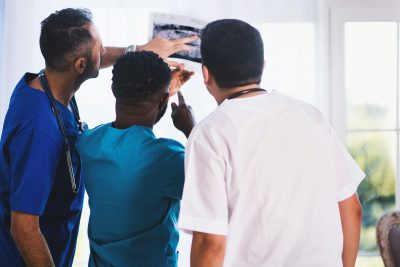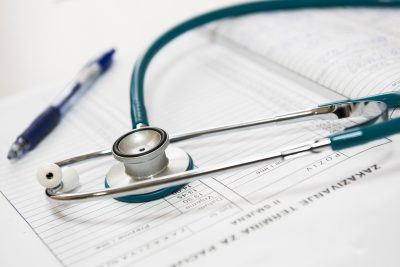The internet of things, aka “IoT” industry has been on the rise for the past five years or so. Companies like Samsung have rolled out appliances like microwaves and ovens that can be controlled on local networks or via Bluetooth. But consumer products are just the beginning. IoT development improves healthcare outcomes too.
The healthcare industry can utilize IoT technology to improve the delivery of care and better collect accurate data.
TLDR; Contents
What Is IoT?
The “internet of things” refers to a network of physical objects that are connected to the internet. They can then send, receive, and exchange data in real time.
You’ve probably seen the smart watch used for calling and texting, but there’s more. This piece of IoT technology monitors health data like heart rate, sleep patterns, and physical activity. All the data lives in the cloud where users can access and analyze their patterns.
As IoT technology improves, more and more things will connect to the internet, letting users collect and store data, and even manage things remotely. Smart home systems, for example, let owners monitor their home from their phone and access lights, locks, and even thermostats.
The medical community is also looking for ways to bring this groundbreaking technology into their industry. In doing so, the healthcare sector has found great potential to both expedite care and improve health outcomes for the patients receiving it.
Collecting Health Data with IoT
One key benefit of the IoT is the timely collection of data. Outside of hospital or clinical settings, healthcare providers must take patients at their word about their symptoms, activity, and treatment plan adherence. With the development of IoT devices, that data can be automatically collected and accessed in real time.
Take blood pressure for example. Using the IoT, someone with hypertension can monitor their blood pressure and instantly send the data to their doctor. Doctors can also reference the incoming data in real time, recognize patterns, and recommend treatment remotely.
While this technology is life-changing for the individual, think of the impact it could have on the field as a whole. The ability to see patterns in populations has implications for disease management, environmental impacts on health, and other health trends that affect groups of people.
How IoT Is Used to Deliver Care
The collection of data via IoT medical devices makes it easy for providers to manage patient care no matter their location. Using this data to deliver care can improve the patient’s health outcomes in a variety of ways.
Timely Delivery of Care
In healthcare, urgency is everything. A health condition that goes unnoticed and untreated over time can become a life-threatening (and expensive) health emergency. With acute conditions, patients need to quickly access their doctor and start treatment.
For high-risk patients who live alone—a situation many find themselves in—IoT devices have the potential to quickly recognize a critical change in vital signs and notify healthcare providers and first-responders. An event like a heart attack, stroke, or fall becomes far less deadly if an IoT device can intervene to expedite life-saving care.
Beyond alerting healthcare providers to health emergencies, IoT devices can also automate the delivery of treatment. For patients with diabetes, glucose and insulin management is a matter of life and death. Insulin pumps with integrated glucose monitoring systems allow those with type 1 diabetes to keep track of blood sugar levels with a smartphone. With just a click, they can make the decision to increase or decrease the amount of insulin their pump delivers.
For those managing diabetes, a quick response when blood sugar levels are either too low or too high is crucial. Devices using IoT simplify the response process to allow for quicker treatment. Some say this insulin delivery process could someday be completely automated, though there are barriers to fully depending on a machine to make such decisions automatically.
Lifestyle Management
For many smartphone users, IoT has opened up a world of apps which collect data about the user’s diet, exercise, and other health factors. These apps can make recommendations in response. MyFitnessPal, for example, lets users automatically track their physical activity and integrate this information into a high level health plan.
Many health conditions require lifestyle changes such as diet and exercise. The development of IoT-enabled apps helps patients and healthcare providers monitor these changes. A healthcare provider may even send recommendations for lifestyle changes through these apps in response to the data they receive.
In this way, health data can continuously inform the lifestyle recommendations patients receive and empower them to track their progress with immediate feedback.
Treatment Plan Compliance
For most healthcare patients, treatment does not stop when they walk out of the hospital. Many people depend on prescription medications and other supplements to manage health conditions. For doctors, there is no way to guarantee that a patient will stick to a treatment plan with 100% consistency. In fact, many patients fail to keep up their end of the treatment plan at all.
Medication non-adherence is a costly problem for the healthcare industry. Not only does it cause billions of dollars in medication waste each year, but it also plays a big role in hospitalizations and health complications. Unfortunately, an estimated 3 out of 4 patients do not take their medications as directed.
IoT devices improve medication adherence and keep patients on their treatment plan. For example, IoT-enabled pill boxes connect with a smartphone to track when a patient takes their daily medicine, sending a reminder to their phone when they forget.
While the hope is for this technology to increase medication adherence, the data collected also helps healthcare providers make informed decisions about their patient’s condition and treatment plan.
Developing IoT Improves Health Outcomes
The constant flow of health data between patients and providers via IoT technology only serves to increase access to care.
With the growing popularity of telehealth, patients may soon find themselves needing to visit an actual hospital only when they need direct treatment for acute conditions. Otherwise, the doctor visit—including monitoring of vital signs and collection of other health data—may soon become totally virtual.
At the very least, managing treatment can be more coordinated through IoT devices. Healthcare experts agree that because of the timeliness of data collection and analysis, quality healthcare delivery and management are now more accessible than ever.
The increased ability to make data-informed treatment decisions is leading to improved health outcomes, and has the potential to save lives.
It’s exciting to see the role IoT will play as we discover new and improved ways to integrate healthcare delivery and improve health outcomes.
Want to discuss your idea for IoT technology?
Click here for a free consultation with one of our experts!







